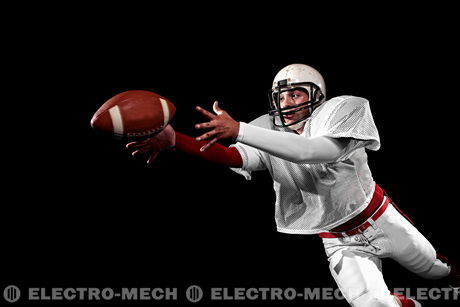
- Among football positions, linebacker is one of the most demanding. A linebacker must be equally skilled at run defense and pass defense
- Linebackers must be quick so that they can cover large areas of the field. They must also be strong enough to defeat moving blockers and agile enough to make tackles in the open field
- According to defensive football drills expert Tom Bass, linebacker drills should emphasize moving on the ball, defeating blocks, dropping into pass coverage, and blitzing the quarterback. Agility drills and interceptions drills are also helpful
Moving on the Ball
To move on the ball effectively, a linebacker must first take a proper stance. An inside linebacker should have his feet square and apart about shoulder-width. He bends his knees a little and is slightly crouched so that his shoulders are ahead of his feet. The hands should be out in front of the body about chest-high, with the elbows kept close to the torso. Once in the proper stance, the linebacker should focus on the ball so that he can move the instant it is snapped. An effective defensive football drill for this is to have the coach kneel down and hold the ball in a center’s position and then move the ball slightly. The linebackers move at the first sign of motion.
When moving ahead, the linebacker should take compact, choppy steps so that he can stay balanced and effectively take on blockers. When moving to the side, the linebacker takes a shuffle step in the direction he wants to go and then slides his trailing foot so that his feet are apart only the width of the hips. When dropping back into pass coverage, the linebacker begins with a crossover step that helps him to turn around. An agility drill related to this is to have the linebackers switch between running forward and running backward. The linebacker begins the drill by backpedaling at half speed when the coach calls “Hut!” After 10 yards the linebacker switches to running forward by taking a crossover step to the left and coming in at a 45 degree angle. The drill is repeated but this time the crossover is to the right. As the drill is repeated, the linebacker should increase his backpedaling speed.
Defeating Blocks
Defeating blocks is also a key linebacker skill. The linebacker must quickly determine who is going to try to block him and what type of block will be used. The linebacker needs to know which gap in the offensive line he is responsible for and end up on that side of the blocker. The linebacker must attack the block. If the blocker comes straight at the linebacker with a drive block, the linebacker should try to initiate the contact so that his shoulder pads are lower than the blocker’s shoulder pads. He then puts his hands on the blocker’s chest and pushes the blocker away. If a tight end comes laterally at a linebacker and leads with a shoulder to make a hook block, the linebacker needs to extend his arms and initiate contact by shoving at the shoulder pad. If a tackle or wingback comes at a linebacker from the side with an angle block, the linebacker needs to lean into the blocker and initiate contact with the shoulder of one arm while striking with the palm of the other arm to knock the blocker off balance.
A linebacker drill to defeat a drive block involves linebackers and blockers facing off one on one. The drill begins at half speed and is speeded up once the linebacker masters the technique. The linebacker must move forward low to attack the blocker’s chest and push the blocker away so that the linebacker’s head is on the side that is his gap responsibility.
Dropping into Pass Coverage
In pass coverage, the linebacker is most often responsible for a running back. In man-to-man coverage, he begins his coverage by backpedaling at an angle that matches the direction that the running back is going. When the linebacker recognizes the pass pattern or when the running back gets within 3 yards of the linebacker, the linebacker switches to a forward run and angles toward the running back. It is vital that the linebacker learn to recognize the different types of pass patterns that running backs execute. In zone coverage, the linebacker sprints to his assigned zone and then backpedals so that he is deep in the zone. As he backpedals he looks at the quarterback to determine where the ball is going, and he adjusts his movement to get to that point.
In a linebacker drill that practices zone coverage, the coach lines up as the quarterback and calls out the zone that the linebacker is to drop into. The coach calls “Hut!” and then raises the ball to pass when the linebacker has reached the zone. The linebacker reacts to the throwing motion by adjusting his position in the zone. The coach finishes the drill by throwing an actual pass to the linebacker. In this way the drill also functions as an interception drill. Linebackers need to work on their hand position when making interceptions. If the ball is at the level of the numbers on their jersey or lower, they need to reach out with their palms up and their little fingers touching. If the ball is above their numbers or out to the side, they need to reach out with their thumbs touching and their wrists cocked so that their palms are perpendicular to the ground.
Tom Bass has also developed drills for defensive backs, running backs, defensive lineman, and wide receivers, as well as other positions. His book Football: Skills & Drills (Human Kinetics Publishers, 2004) provides more details on the drills described above as well as other linebacker drills, such as tackling drills and blitzing drills.
As an electronic scoreboards continue to light up.
